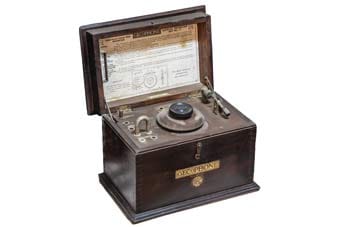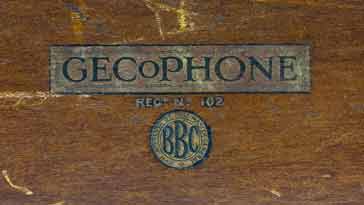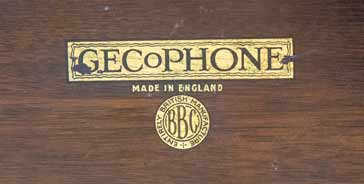BBC Type Approval Stamp & GPO Registration Number
In the early days of broadcasting in Britain, radio manufacturers were required to submit radios and gain BBC type approval and a GPO registration number - the type registration marks can be seen on a number of British vintage radios.
Radio Receiver History Includes:
Radio history / timeline
Radio receiver history
Superhet radio history
Classic vintage radio receivers
Many very early commercially made British vintage radios or antique radios bear a BBC type approval stamp and carry a registration number to meet the regulations for the time.
This was a system for radios in the United Kingdom that required the before a radio went into production, a sample was to be sent to the Post Office to test that it did not produce electrical interference.

This actually shows the BC1001 version as there is no cover on the crystal detector
Type approved sets were given their own General Post Office, GPO, registration number which was displayed on the set, along with a stamp with the words 'TYPE APPROVED BY THE POST MASTER GENERAL'.
The scheme required that a royalty be paid to the BBC on each set produced, and the amount was not insignificant. This revenue was essential during the first two years of the British Broadcasting Company because it used these royalties to fund its operations. In essence this was an early licence fee.
Founding of the type approval stamp
Much of the need for the BBC stamp came out of the requirement to fund the broadcast transmitting stations as well as covering the ongoing cost of maintenance and programming. This was achieved in a number of ways.

The BBC as we know it was initially set up in 1922 as the British Broadcasting Company Ltd. It was a company which was set up by a number of radio manufacturing firms that realised if they were going to sell broadcast receiving equipment, they needed to have broadcast stations for people to receive.
The BBC was the organisation that was set up to provide the stations and run them. It started with just eight transmitting stations, located around the UK in major population centres.
In fact the transmitters were often located in the centre of cities, unlike the situation today where transmitters tend to be located on high points away from city centres to give widespread coverage.
Not only were there set up costs for the transmitters, but they also needed to be maintained and the programmes needed to be prepared, although during these days the production costs would not be like they are today.
The BBC needed to cover its costs and this was achieved using a variety of levies and fees.
Broadcast receiving licence
One of the methods for funding the BBC was through an annual wireless receiving licence that cost cost 10 shillings (50p in today's UK money).
This licence initially only permitted the use of wireless sets made by members of the BBC. There was a real fear, that equipment could be imported from abroad that would avoid the royalties and would therefore be much cheaper, thereby defeating the funding methods used for the BBC.
To ensure that it was obvious which wireless sets were authorised, each set carried a special mark. Half the licence fee would go to the BBC to fund their operations.
Royalty fees
The wireless sets carried two further tariffs. One was charged on the components within the radio and this would go to the BBC.
A further tariff of 12s 6d (62.5p in today's UK currency) was charged on each valve-holder within the radio. This was a royalty for the Marconi Company for the use of valves for which they held various patents.
Technical certification
Equipment was also required to undergo a type approval test to ensure that the equipment was fit for purpose. Tests were carried out to ensure they operated correctly and also that they did not cause interference to other people receiving the broadcast transmissions.
In the early days of broadcasting, despite the very high cost of valves, regenerative wireless sets were being developed and sold. If the circuit design was not suitable, these could easily radiate a large signal and interfere with other local radio receivers.
To gain type approval, companies manufacturing wireless receivers were required to submit a trial radio to the General Post Office to be tested to ensure that it conformed to the requirements of the day.
BBC stamp and registration timeline
The BBC stamp and registration scheme was relatively short lived, but while it was in force, it applied to all commercially made radios in Britain.
In order to understand a little more about the scheme, it can help to have a timeline of what happened and when the various elements of it were in force. These changed relatively quickly because broadcasting was a new concept at the time.
18 October 1922: The British Broadcasting Company was formed. Under the auspices of the new BBC, new wireless transmitting stations would be set up and run under one company rather than experimental broadcasting stations being set up by companies like the Marconi Company, or enthusiastic radio amateurs.
1 November 1922: The scheme was introduced for the United Kingdom under which all commercially manufactured radio receivers (crystal sets as well as valve radios) and valve amplifiers bought had to be of British manufacture, made by a company that was a member of the British Broadcasting Company and the equipment had to be approved by the Post Master General.
All wireless equipment bore the BBC / PMG stamp and a GPO registration number that was given to that particular model of wireless. Royalties were also paid on components as well.
14 November 1922: Following the closure of broadcasting by amateur radio stations, the first broadcasts from the BBC took place from their London station with the callsign 2LO.
15 November 1922: Broadcasts started from new stations in Birmingham (callsign 5IT) and Manchester (callsign 2ZY).
24 December 1922: The new station 5NO starts broadcasting from Newcastle.
13 February 1923: Broadcasts for Cardiff start as 5WA makes its first broadcast.
13 February 1923: Broadcasts for Cardiff start as 5WA makes its first broadcast.
1 October 1923 : Royalties on BBC / PMG stamped wireless equipment were reduced as the system settled and broadcasting became more established. The royalties were also completely abolished on valves, headphones and loudspeakers.
In addition to the reduction and removal of royalties, the General Post Office requirements for broadcast receivers were significantly changed. The testing of sets regarding their reaction controls was removed and manufacturers were only required to advise purchasers of the possibility of causing interference to others if the control was advanced too far.
Newly designed receivers still had to be submitted to the Post Office for type approval testing and those approved were still given a GPO registration number. The extent of the testing was reduced as the wireless sets were only given reception tests to see if they were capable of covering the broadcast band which had by now been extended to cover 300 to 500 metres.
1 July 1924: All royalties on BBC/PMG stamped equipment were removed. This enabled anyone with a broadcast receiving licence to purchase receiving sets from any British manufacturer and not just those who were members of the BBC.
Member companies still had to exhibit the BBC / PMG stamp on their wireless equipment, even though there was now no requirement to submit them for approval.
1 January 1925: On this date, all the regulations governing the display of BBC stamps on wireless equipment were ended. Member companies of the BBC were no longer required to display the stamp on their products, although many continued to do so as it gave additional status and provided an additional sales advantage.
By the end of 1927 the practice of using the BBC approval stamp had died out and manufacturers no longer used them on their products.
Note: the dates that are in bold refer to the actual dates of changes to the BBC stamp and GPO type approval scheme. The dates not in bold refer to the dates when stations started on the air and these give some context to the main dates.
It is interesting to note that the GECoPHONE BC2830 which was introduced in 1927 had a BBC stamp on the top cover even though this was no longer required by law. This vintage radio bore no registration number to show that it had been submitted for type approval. This shows how the BBC stamp still gave purchasers a sense of security in what they were buying.


Wireless registration numbering
When each wireless set was submitted for type approval, the radio was tested by the General Post Office, GPO in the UK, and if it passed, that radio or wireless set type was given a registration number.
It appears that different types of vintage radio were given numbers in different series so that crystal sets were distinct from various forms of valve / tube based radios, etc. However, some of the higher numbers were less well defined, probably as the number of radios being submitted increased and it became less viable to categorise them into the different number blocks.
A few examples are given below:
| Registration Numbers for Early Wireless Units Under GPO Approval Scheme |
|
|---|---|
| Registration Number | Radio Type |
| 100 - 999 series: crystal sets | |
| 100 | Marconi Junior Crystal Set |
| 101 | Marconi Crystal Set A |
| 102 | GECoPHONE No 1 |
| 103 | GECoPHONE No 2 |
| 1000 - 1999: 1 valve wireless sets | |
| 1043 | Gamages 1 valve vintage radio |
| 1583 | McMichael MHBB1 |
| 2000 - 2999: 2 valve wireless sets | |
| 2000 | GECoPHONE BC2001 |
| 2001 | Marconi V2 |
| 3000 - 3999: amplifiers for wireless sets | |
| 3015 | Audiophone 1 valve amplifier |
| 3073 | Broadway Radio Works 1 valve amplifier |
| 4000 - 4999: various equipments | |
| 4012 | Lintophone Junior Crystal Set |
| 5000 - 5999: various equipments | |
| 5393 | GECoPHONE BC3000 1 valve amplifier |
The BBC / GPO type approval and stamp system was an initial method of funding the new broadcast stations that had been set up in the UK. Although it was finished after only a couple of years, the scheme did mean that broadcast stations were able to be set up and operate, giving access to over 70% of the population within a short space of time.
 Written by Ian Poole .
Written by Ian Poole .
Experienced electronics engineer and author.
More History:
Radio history timeline
History of the radio
Ham radio history
Coherer
Crystal radio
Magnetic detector
Spark transmitter
Morse telegraph
Valve / tube history
PN junction diode invention
Transistor
Integrated circuit
Quartz crystals
Classic radios
Mobile telecoms history
Vintage mobile phones
Return to History menu . . .



